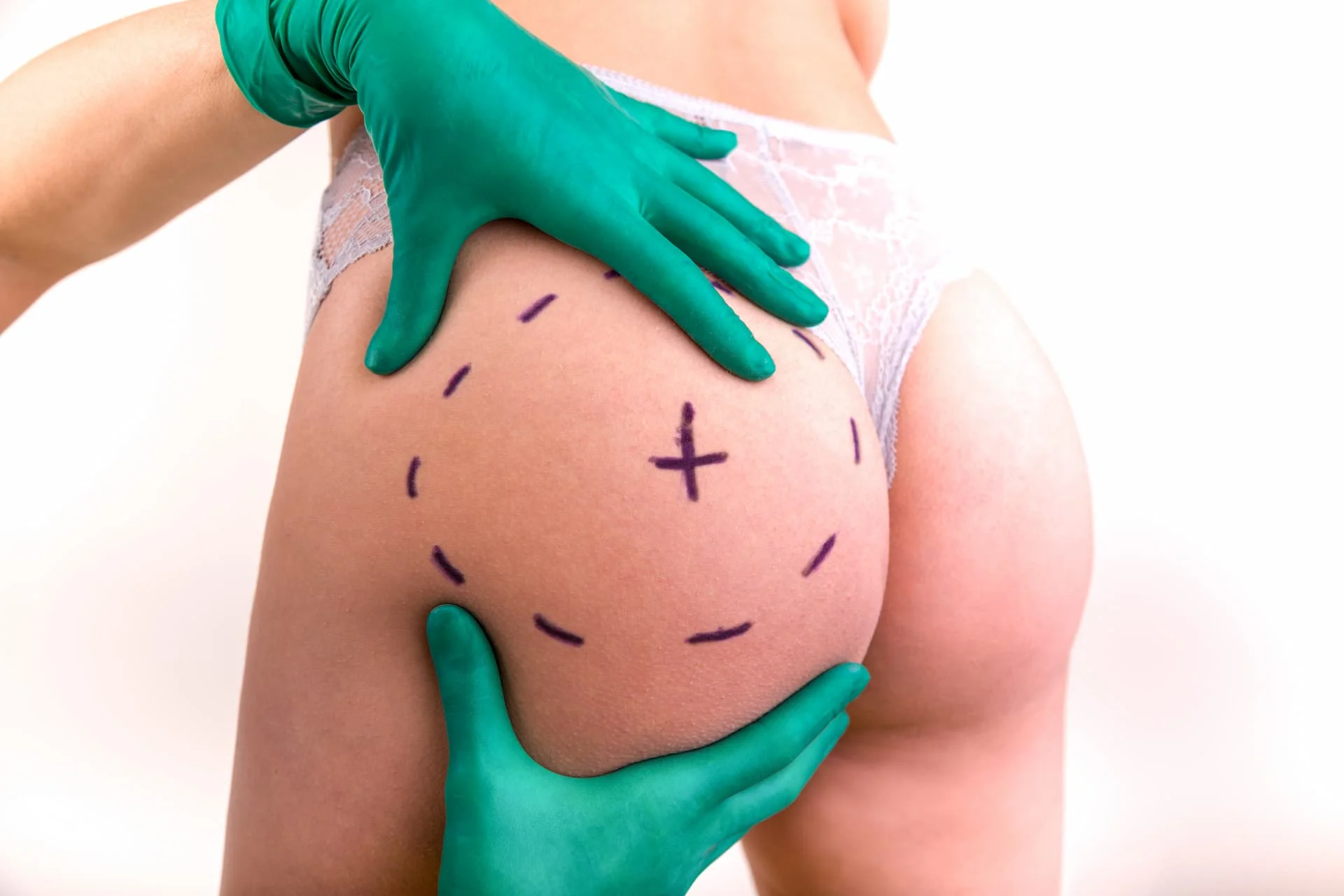In the realm of aesthetic medicine, the desire for a well-proportioned and shapely physique has led to significant advancements in body contouring procedures. Among these, buttock implants have emerged as a highly effective solution for individuals seeking to enhance the volume, projection, and overall shape of their gluteal region. This comprehensive guide delves into the intricacies of gluteal augmentation with implants, offering an authoritative perspective on the procedure, its benefits, associated risks, and the compelling reasons why patients, particularly from the United Kingdom, are increasingly choosing Turkey for this transformative surgery.
Table of Contents
Understanding Buttock Implants: An Overview
Gluteal augmentation with implants is a sophisticated surgical procedure designed to improve the size and shape of the buttocks. It involves the precise placement of silicone implants to create a fuller, more rounded, and aesthetically pleasing contour. This intervention is particularly sought after by individuals who find that diet and exercise alone do not yield the desired gluteal enhancement.
What are Buttock Implants?
Buttock implants are medical-grade silicone prostheses specifically designed for gluteal augmentation. These implants are distinct from those used in breast implant procedures, featuring a firmer consistency that allows for greater projection and durability in a weight-bearing area. They come in various shapes and sizes—round, oval, or anatomical—to cater to diverse aesthetic goals and anatomical considerations. The choice of implant shape and size is a critical decision made in consultation with a qualified surgeon, ensuring the outcome is both natural-looking and harmonious with the patient’s overall body structure. The material, a solid yet flexible silicone, is engineered for long-term integration and resilience, mirroring the advancements seen in other implant technologies such as dental implants.
Who is a Candidate for Buttock Implants?
Ideal candidates for buttock implants are typically adults in good general health, with realistic expectations about the surgical outcomes. They often present with one or more of the following concerns:
- Lack of natural volume: Individuals with a naturally flat or underdeveloped gluteal region.
- Asymmetry: Patients seeking to correct unevenness in buttock size or shape.
- Weight loss aftermath: Those who have experienced significant weight loss, leading to a diminished or deflated appearance of the buttocks.
- Desire for enhanced projection: Individuals aiming for a more prominent and lifted posterior profile.
A thorough consultation with a board-certified plastic surgeon is imperative to assess suitability, discuss individual aesthetic goals, and determine the most appropriate surgical approach. Patients must be non-smokers or willing to cease smoking prior to surgery, and free from any medical conditions that could impair healing or increase surgical risks.
The Procedure: What to Expect
The journey towards enhanced gluteal contours through buttock implants is a meticulously planned process, from initial consultation to the surgical intervention itself. Understanding each phase is crucial for patient preparedness and ensuring optimal results.
Pre-operative Preparation
Careful preparation is key to a successful outcome and smooth recovery. Patients undergoing gluteal augmentation will receive detailed instructions from their surgical team. These typically include:
- Medical Evaluation: Undergo a comprehensive medical examination, including blood tests and possibly an electrocardiogram, to ensure fitness for surgery.
- Medication Review: Disclose all medications, supplements, and herbal remedies to your surgeon. Certain medications, such as blood thinners (aspirin, ibuprofen), may need to be discontinued a week or two prior to surgery to minimize bleeding risks.
- Smoking Cessation: If you smoke, it is imperative to stop at least 4-6 weeks before and after surgery. Smoking significantly impairs circulation and healing, increasing the risk of complications.
- Avoid Alcohol: Refrain from alcohol consumption for at least a week before surgery.
- Arrange for Support: Secure assistance for post-operative care, including transportation home and help with daily activities during the initial recovery period.
- Nutritional Guidelines: Follow any dietary recommendations provided by your surgeon, focusing on a healthy, balanced diet.
- Hydration: Maintain good hydration in the days leading up to the procedure.
Surgical Techniques
Buttock implants are typically inserted through a discreet incision, often placed within the gluteal crease, making the resulting scar well-concealed. The surgeon creates a pocket for the implant, which can be positioned either submuscularly (beneath the gluteus maximus muscle), intramuscularly (within the muscle), or subfascially (beneath the fascia). The submuscular placement is generally preferred for its ability to provide better implant coverage, reduce palpability, and offer a more natural contour. This technique demands exceptional surgical precision and a deep understanding of gluteal anatomy to ensure both aesthetic success and patient safety.
Anaesthesia and Duration
Gluteal augmentation surgery is typically performed under general anaesthesia, ensuring the patient is completely unconscious and pain-free throughout the procedure. The duration of the surgery usually ranges from 2 to 3 hours, depending on the complexity of the case and the chosen technique. Post-anaesthesia, patients are carefully monitored in a recovery room before being moved to a private room for overnight observation, or discharged, depending on the clinic’s protocol and the patient’s condition.
Recovery and Post-Operative Care
Recovery from gluteal augmentation with buttock implants requires careful adherence to post-operative instructions to ensure proper healing and the best possible aesthetic outcome. Patients should anticipate a period of limited mobility and discomfort.
Immediate Post-Surgery
Following surgery, patients will experience swelling, bruising, and discomfort, which can be managed with prescribed pain medication. A compression garment will be applied to minimize swelling and support the new contours. Patients are usually advised to avoid direct pressure on the buttocks for the initial weeks. This means avoiding sitting directly on the implants; special pillows or lying on the stomach may be recommended. The first few days are crucial for managing pain and initiating the healing process. Patients might spend one night in the hospital for observation, ensuring that any immediate complications are addressed promptly.
Long-Term Recovery Timeline
Effective long-term recovery is a gradual process that requires patience and consistent adherence to medical advice.
- Week 1: Significant swelling and bruising are present. Pain is managed with medication. Patients must avoid sitting directly on the buttocks and sleep on their stomach or sides. Light walking is encouraged to promote circulation and prevent blood clots.
- Weeks 2-4: Swelling begins to subside, and discomfort lessens. Patients can gradually increase their activity level, but strenuous exercise and heavy lifting are still prohibited. Sitting duration should remain limited, typically on a specially designed cushion or in a modified position.
- Months 1-3: Most of the swelling should have resolved, revealing the final shape. Patients can typically resume most normal activities, including light exercise. The compression garment may still be recommended for certain periods. The implants settle into their permanent position during this time.
- Month 6 onwards: Full recovery is generally achieved. The incisions will have matured, and the final aesthetic result becomes apparent. Regular follow-up appointments with the surgeon are important to monitor progress and address any concerns.
Essential Post-Operative Instructions
Adhering to specific guidelines is paramount for a smooth recovery and to prevent complications.
- Wear your compression garment: This helps reduce swelling and supports the newly shaped buttocks. Wear it as advised by your surgeon, usually for several weeks.
- Avoid direct pressure: Do not sit directly on your buttocks for at least 2-3 weeks, or as directed. Use a special pillow (like a BBL pillow) or assume a modified position (e.g., sitting on your thighs) to offload pressure.
- Sleep on your stomach: This prevents pressure on the implants and promotes optimal healing.
- Maintain hygiene: Keep incision sites clean and dry to prevent infection. Follow specific wound care instructions.
- Take prescribed medications: Adhere strictly to the dosage and schedule for pain relief and antibiotics.
- Avoid strenuous activity: Refrain from heavy lifting, intense exercise, and activities that strain the gluteal muscles for several weeks to months.
- Attend follow-up appointments: Regular check-ups allow your surgeon to monitor your healing process and address any concerns.
Benefits and Risks of Buttock Implants
Gluteal augmentation with implants offers significant aesthetic benefits but, like all surgical procedures, carries potential risks that must be carefully considered.
Aesthetic Outcomes and Patient Satisfaction
Buttock implants can dramatically improve the aesthetics of the gluteal region, providing enhanced volume and projection that is often unattainable through exercise alone. Patients typically report high levels of satisfaction with the results, enjoying a more curvaceous and balanced silhouette. The implants can correct asymmetry, create a more youthful appearance, and significantly boost self-confidence. The results are long-lasting, providing a permanent solution for individuals seeking sustained gluteal enhancement.
Potential Complications and How to Mitigate Them
While generally safe when performed by experienced surgeons, potential risks associated with buttock implants include:
- Infection: Though rare, infection can occur and may require implant removal. Meticulous surgical technique and post-operative care significantly reduce this risk.
- Capsular Contracture: The formation of scar tissue around the implant, which can harden and cause discomfort or distortion. This is less common with buttock implants than with breast implants due to differences in implant consistency and placement.
- Implant Displacement: The implant may shift from its original position, requiring corrective surgery. Proper surgical pocket creation and post-operative care are crucial in preventing this.
- Seroma/Hematoma: Fluid or blood accumulation near the surgical site. Drains may be placed during surgery to minimize this risk.
- Nerve Damage: Temporary or, rarely, permanent numbness or altered sensation. This risk is minimized by anatomical precision during surgery.
Choosing a highly qualified and experienced surgeon is the most critical step in mitigating these risks, as their expertise directly impacts surgical precision and complication avoidance.
Advancements and Safety in Gluteal Augmentation
Modern plastic surgery has made considerable strides in refining techniques and improving the safety profile of procedures such as gluteal augmentation. Contemporary approaches to buttock implants prioritize both aesthetic excellence and patient well-being.
Modern Implant Technology
The implants themselves have evolved, featuring highly cohesive silicone gels that maintain their shape while offering a natural feel. These advanced implants are less likely to rupture or leak compared to older generations. Furthermore, the development of anatomical shapes allows for a more customized and natural enhancement, tailored to each patient’s unique body contours. Research continues to refine implant materials and designs, aiming for ever-greater safety and durability, similar to the continuous improvements seen in chin implant technology.
A systematic review by Al-Fulaij et al. (2022) in *Plastic and Reconstructive Surgery Global Open* critically assessed the safety and efficacy of gluteal augmentation with silicone implants. The findings indicated that while complications such as infection and seroma can occur, their incidence is low when the procedure is performed by experienced surgeons using appropriate techniques. The review concluded that gluteal implants are generally safe and effective for patients seeking buttock enhancement, with high patient satisfaction rates reported when realistic expectations are managed and proper surgical protocols are followed.
Importance of Surgeon Expertise
The success and safety of gluteal augmentation are profoundly linked to the surgeon’s skill and experience. A board-certified plastic surgeon with extensive experience in buttock implants understands the intricate gluteal anatomy, can accurately assess patient suitability, and is adept at selecting the appropriate implant type and placement technique. Their expertise is crucial in minimizing risks and achieving predictable, aesthetically pleasing results. Patients are strongly advised to verify their surgeon’s credentials, review before-and-after portfolios, and engage in thorough discussions regarding their experience with gluteal augmentation.
Buttock Implants: Turkey vs. United Kingdom Price Comparison
For international patients, particularly those from the United Kingdom, the cost-effectiveness of medical procedures in Turkey is a significant factor. While the quality of care remains paramount, the financial accessibility of buttock implants in Turkey provides a compelling advantage.
| Service/Item | Turkey Price (GBP) | United Kingdom Price (GBP) |
|---|---|---|
| Buttock Implants (Standard) | £3,500 – £5,500 | £7,000 – £12,000 |
| Consultation (Initial) | £0 – £150 | £150 – £300 |
| Post-Op Garment | Included – £150 | £100 – £250 |
| Follow-up Care | Included | Included |
| Anesthesia Fees | Included | £500 – £1,000 |
*Prices are estimates and can vary based on clinic, surgeon experience, and specific procedure details.*
This table illustrates the substantial cost savings that can be achieved by choosing Turkey for gluteal augmentation. These savings often extend to accommodation and travel packages, making the overall experience more accessible without compromising on surgical excellence or patient safety.
Comparing Gluteal Augmentation Options
When considering buttock enhancement, patients often weigh various approaches. Beyond implants, fat transfer (Brazilian Butt Lift or BBL) is another popular method. Understanding the key differences is essential for making an informed decision.
| Factor | Buttock Implants | Fat Transfer (BBL) |
|---|---|---|
| Volume/Projection | Significant, predictable | Moderate to significant, less predictable (fat absorption) |
| Material | Medical-grade silicone | Autologous fat (from patient’s own body) |
| Donor Sites Required | No | Yes (for liposuction) |
| Longevity | Permanent (unless removed) | Long-lasting, but some fat is naturally reabsorbed |
| Recovery | Specific restrictions on sitting | Similar sitting restrictions, liposuction recovery |
| Ideal Candidate | Thin patients lacking fat, desire for distinct shape | Patients with sufficient donor fat, desire for natural fullness |
This comparison highlights that buttock implants are particularly beneficial for individuals who lack sufficient body fat for transfer or desire a very specific, pronounced gluteal shape that implants can reliably provide. Fat transfer, while natural, is dependent on the availability of donor fat and often involves a higher degree of unpredictability due to fat reabsorption.
Choosing CK Health Turkey for Your Buttock Implants Journey
CK Health Turkey stands as a premier destination for international patients seeking high-quality medical aesthetic procedures, including gluteal augmentation with buttock implants. Our commitment to patient safety, exceptional surgical outcomes, and comprehensive care distinguishes us as a leader in medical tourism. We pride ourselves on offering a seamless experience, from initial consultation to post-operative follow-up, ensuring that every patient feels supported and confident throughout their journey.
Our facilities boast state-of-the-art technology and are staffed by a team of highly qualified, board-certified plastic surgeons with extensive experience in gluteal augmentation. We understand the unique needs of international patients and provide tailored services, including multilingual support, accommodation assistance, and personalized treatment plans. Patients considering procedures like bariatric surgery or other complex interventions will find the same level of dedication and excellence. Choosing CK Health Turkey means opting for world-class medical expertise, significant cost advantages, and a compassionate approach to patient care.
We invite you to discover the difference CK Health Turkey can make in achieving your aesthetic goals. Get in touch with our dedicated team today to schedule your consultation and learn more about how we can support your transformation. Visit our website to explore our range of services and begin your journey towards a more confident you.
FAQs
How long do buttock implants last?
Buttock implants are designed to be a permanent solution. Unless complications arise, such as infection or displacement, they do not need to be replaced.
Is buttock implant surgery painful?
Patients will experience discomfort and soreness, particularly in the initial weeks after surgery. However, this is typically managed effectively with prescribed pain medication.
Can I sit normally after buttock implant surgery?
Direct sitting on the buttocks is restricted for the first 2-3 weeks to allow implants to settle and prevent pressure. Special pillows or modified sitting positions are advised.
How soon can I return to work after buttock implants?
Most patients can return to light work within 2-3 weeks, provided their job does not involve strenuous physical activity or prolonged sitting. Full recovery for demanding jobs may take longer.
Are buttock implants noticeable or unnatural-looking?
When performed by a skilled surgeon, buttock implants are designed to look and feel natural. The choice of implant size and shape is crucial for a harmonious result that complements your body.
What is the difference between buttock implants and a Brazilian Butt Lift (BBL)?
Buttock implants use silicone prostheses to add volume. A BBL involves liposuction to harvest fat from other body areas, which is then purified and injected into the buttocks. Implants are better for very thin patients or those desiring more dramatic projection.
What are the risks of buttock implant surgery?
Risks include infection, implant displacement, capsular contracture, seroma, and nerve damage. These are minimized by selecting an experienced, board-certified surgeon and following all post-operative instructions.
Can I exercise after getting buttock implants?
Light walking is encouraged early in recovery. Strenuous exercise, particularly activities targeting the glutes, should be avoided for several months, typically 3-6 months, as advised by your surgeon.



